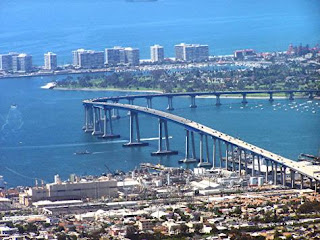America's Broken Bridges
By Carol Wolf
Tappan Zee Bridge 1955
Every day about 140,000 cars and trucks cross the massive, seven-lane Tappan Zee Bridge connecting the northern suburban counties of New York City. Most drivers have no idea the 57-year-old bridge was designed in such a way that if just one of its structural elements gives way, the whole bridge could fall and send them tumbling into the Hudson River. The same is true for the Pulaski Skyway between Newark and Jersey City,
Pulaski Skyway opened in 1932 Jersey City,NJ
and the San Diego-Coronado Bridge in California, not to mention the Fremont Bridge in Portland, Ore., the
Lafayette Bridge in St. Paul, Minn., and thousands of others across the country.
Coronado-Bridge-San-Diego
Five years after the Minneapolis I-35W span suddenly collapsed in August 2007, killing 13 people and injuring 145 others, the U.S. still has 18,000 similarly designed spans, known as fracture-critical bridges, that need continual attention and money for inspections at a time when funding for maintenance is drying up. On March 31, the current extension to the federal highway bill, which funds work on bridges, will expire. Congress has been working on new legislation since the fall, getting nowhere. The Senate passed a two-year, $109 billion highway spending package on March 14 that would raise money for
transportation projects by changing how pension fund contributions and liabilities are calculated. House Speaker John Boehner (R-Ohio) is pushing a five-year bill that calls for using royalties from U.S. oil and gas drilling—a proposal he hasn’t been able to sell to his own party.
The delays and political bickering aren’t reassuring for commuters who rely on the San Diego-Coronado or any of the other fracture-critical bridges. “They don’t give any warning at the point of collapse,” says Thomas Fisher, dean of the College of Design at the University of Minnesota. “It is sudden and catastrophic.”
Engineers still build fracture-critical bridges, but they do so with stronger steel and more sophisticated welding and riveting than they used in the 1960s and 1970s. The clock is ticking on the bridges built back
Coronado-Bridge-San-Diego
then—like the former Minneapolis I-35W span, completed in 1967 and 40 years old when it gave way. Andrew Herrmann, president of the American Society of Civil Engineers, a Reston (Va.)-based industry association, says the average fracture-critical bridge from that era has a life of about 50 years. “These bridges have an amazing safety record to this point,” Herrmann says, “but they are getting old and have to be watched.”
U.S. Department of Transportation rules say states must inspect every bridge that’s 20 feet or longer at least once every two years. The agency lets state officials decide whether to put fracture-critical structures on a stricter schedule; some need more frequent inspections, depending on the steel grade and the weather and traffic they’re exposed to.
It’s labor-intensive work. Engineers use boats, cranes, and cherry pickers to get within arm’s reach of a bridge, looking for signs of corrosion or wear. Even miniscule cracks—as small as an eighth of an inch—can spell danger. “If the crack is not arrested, it can run the length of the steel and jeopardize the integrity of the structure,” says Michael Johnson, chief of specialty investigations for the California Department of Transportation. The state requires divers to do underwater inspections of its 214 fracture-critical bridges every five years.
“When you notice something on these bridges, they have to be shut down right away,” says the University of Minnesota’s Fisher. “It’s not like they sag or start to shake first.” That was the case last year when engineers discovered fissures as wide as a soda can on the Sherman Minton Bridge that straddles the Ohio River, connecting Kentucky and Indiana. The 50-year-old span closed in September 2011 and reopened last month after workers finished attaching 2.4 million pounds of steel plating for reinforcement along the sides of the bridge. It carries 80,000 cars and trucks a day.
The hands-on inspections can cost five to 15 times more than a standard visual checkup using binoculars, reaching into the six-digits and eating up state budgets. State and local governments pay up front for the inspections, then apply for reimbursement from Washington to cover a portion of the work. Keeping up that maintenance could become a problem in October. That’s when the federal pot of money that helps pay for bridge inspections and repairs, known as the Highway Trust Fund, could run dry, according to the Congressional Budget Office. The fund derives its revenue from fuel taxes, which have declined over the last three years as Americans began driving more fuel-efficient cars and buying less gas because of higher prices.
The dwindling money means state officials need to be more vigilant than ever, says Robert Connor, associate professor of civil engineering at Purdue University in West Lafayette, Ind., who studies fracture-critical bridges. “I don’t think the sky is falling today,” says Connor. “But if we don’t train the future workforce in at least how to maintain these structures, we’re going to have some pretty bad things eventually happen.”
The bottom line: The U.S. has 18,000 bridges that could collapse without warning, requiring more costly inspections while funding becomes scarce.
America's Broken Bridges
Brian Wingfield,
Drive across a bridge in Oklahoma, Rhode Island or Pennsylvania these days, and there's a pretty good chance that it's in subpar condition.
At least 25% of all highway bridges in those states are "structurally deficient"--meaning that they need to be "monitored and/or repaired," according to the Federal Highway Administration. By contrast, less than 4% of the bridges in Arizona, Nevada and Florida that handle auto traffic are in similar shoddy shape.
Take Oklahoma, which boasts the greatest percentage of structurally deficient bridges in the country, 27%. Just two years ago, the state allocated about $200 million (about 4% of its annual budget) for transportation funding--nowhere near enough to cover administration, maintenance and new projects, says Mike Patterson, chief financial officer for the Oklahoma Department of Transportation. Since then, state legislators have vowed to double funding for transportation projects by 2012.
Last year Pennsylvania spent $558 million, about 35% of the total it allocated for highway and bridge contracts, on bridge construction and repair--and still 25% of its bridges are bad condition. The price tag to spruce up its structurally deficient bridges is $8 billion, says Rich Kirkpatrick, a spokesman for the state's Department of Transportation.
Relative to issues like war and runaway entitlement programs, bridge repair has a hard time competing for Washington's attention, though some are trying to tackle it.
Recommendations
1) As our nation’s bridges continue to age, Congress needs to provide states with increased resources to repair and rebuild them. The federal transportation program currently provides only a fraction of the funds needed for maintenance and repair. Although a number of states are making repair of existing assets a priority, more support from the federal government is essential. The nation’s bridges are aging and traffic demands are increasing, even as state and local revenues are shrinking. Though the size of the federal program increased by 14 percent between 2006 and 2009, state-level needs increased at the same time by 47 percent.
2) Congress also must ensure funds sent to states for bridge repair are used only for that purpose. Today, states can transfer up to 50 percent of their bridge funds to other purposes — even if they have bridges clearly in need of repair. These funds should only be used for other purposes if the state’s bridges are in a state of good repair. In addition, states should be given the flexibility to develop long-term programs that prioritize both keeping bridges in good condition and fixing or replacing deficient bridges. Even in instances where it is more cost-effective to perform regular repair on a bridge to prevent it from becoming deficient, the current federal program only allows states to fix a bridge that is structurally deficient with a low sufficiency rating.
3) Upgrade bridges so that they are safe and accessible for all who use them. Congress should adopt a “complete streets” policy to ensure that when our aging bridges are replaced, they are designed to provide safe access for all who need them, whether in vehicles, on foot or bicycle, or using public transportation.
Transportation for America
1707 L Street NW, Suite 250
Washington, DC 20036
Info@t4america.org
202-955-5543
t4america.org
































No comments:
Post a Comment